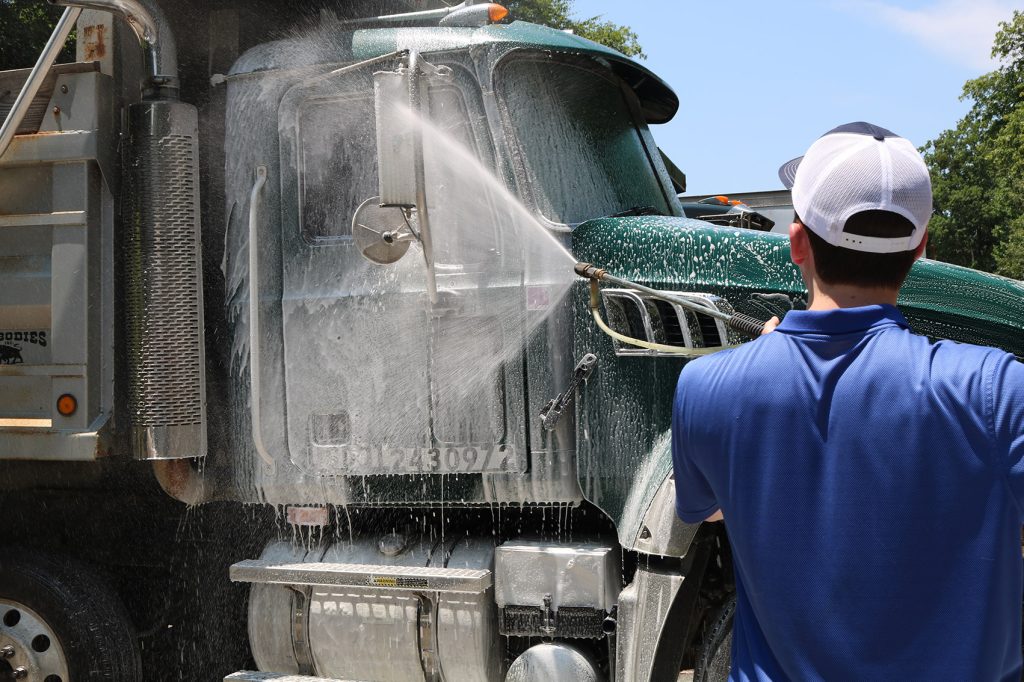Cleaning a big rig is not just cosmetic, it’s a matter of maintenance and safety, let alone efficiency, even when on the road. Truck drivers and fleet owners alike know the value of a clean truck-it speaks volumes about professionalism and attention to care, possibly lessening mechanical issues and allowing for even better gas mileage. Here’s a guide how to wash a semi truck from the gleam of the chrome to the interior’s nooks and crannies.

Start with the Right Tools
Whatever the cleaning routine, it should start with supplies. You wouldn’t cut wood with a hammer; neither should you clean your truck that way. The right tool will make all the difference.
- Exterior: Outside, high-quality soaps developed for automotive application, long-handled brushes, and microfiber cloths are in-store staples. Such supplies prevent scratching the paint while doing an excellent job of removing grime and dirt.
- Interior: Inside the cab, everything from heavy-duty vacuum cleaners to light cleaning agents for sensitive surfaces plays a crucial part. Special attention should be paid to sanitizers for high-touch areas so that it keeps a healthy environment for driving.
The Exterior Cleaning Process
Washing the outside of a big rig is a bit more than the splashing of water and rubbing in some soap. It is actually quite a systematic process, starting with pre-soaking of the truck to loosen the dirt and grime. This pre-soak starts lifting that very first layer of the dirt even before you have started with a soap brush. Soaping up the rig and using a high-pressure rinse serves to wash away residual dirt. This cleans but also prevents streaks from dried soap.
Waxing isn’t just the icing on the cake for drivers who take pride in their vehicle’s appearance; it protects the paint and can have major long-term benefits of reduced wear from the elements and easier cleaning in the future. It is an investment in the truck’s longevity and aesthetic value.
Moving to the Interior
A truck cabin is the driver’s home on the road, so cleaning it is a matter of comfort and hygiene. First of all, remove all the trash that can build up in big quantities after many hours of driving. The second will be vacuuming-underneath seats and down into all crevices-so no crumbs and dirt can collect. Surfaces-dashboards and console-need appropriate cleaning agents that can wipe the dust off without harming the materials.
This step-by-step process will not only keep the truck in top condition but will also provide a pleasant, healthy environment during those long days on the road. Remember, a clean truck goes farther and smooths out the ride for all things and people on board.
Regular Maintenance is Key

Regularly scheduled cleanings can vastly extend the life of your big rig. A consistent routine for drivers can help prevent the build-up of substances that may corrode metal components or destroy the sophisticated paint job of the truck.
Why Consistency Matters
Consistent cleaning doesn’t just prevent the buildup of grime, but also allows motorists to monitor their vehicle for any potential issues that could develop into bigger concerns if not fixed early on. It is easier to notice a new scratch or ding on a clean truck rather than one which has a week of road dust and grime covering all over it.
Tips for Consistent Truck Cleaning
- Set a schedule: Be it weekly, fortnightly, or monthly, giving your big rig a set cleaning schedule keeps it in good condition.
- Check weather conditions: Try to wash your rig on days when the weather is mild. This helps keep dirt from building up so fast after a wash and ensures cleaning agents work effectively.
- Use the right products: Acquire the appropriate cleaning materials that would serve effectively and not damage the paint of your big rigs. Using the wrong or poor quality cleaning materials will do more harm than good.
Addressing the Undercarriage and Engine
Probably one of the most overlooked parts when it comes to cleaning trucks is the undercarriage. That’s where all of that road salt, mud, and general debris collect before starting to rust and break down over time.
Cleaning the Undercarriage
Particularly, the undercarriage should be washed deep and frequently, especially when driving a truck in those states that use road salt because of snow and ice. Most residues, that are harmful to protective coatings, may be removed by high-pressure washes. This will protect the vital components of your truck from wear and tear.
Engine Maintenance
While important, cleaning the outside and interior of the truck is not as crucial in terms of performance and life as how well the engine is cleaned. Overheating, along with other mechanical failures, can be prevented by periodic examination and cleaning of the engine: check for oil residue, air filters cleanliness, and the engine compartment free from debris that is not needed.
By keeping your big rig looking good and its underlying mechanical systems in good shape, you keep it running smoothly and dependably. This not only minimizes the chances of problems on the highway but also helps retain the truck’s resale value. Cleanliness in a big rig goes much deeper than the skin — it’s part of the very foundation of successful, long-term vehicle management.
Cost-Effective Cleaning Strategies

While maintaining a big rig is crucial for any truck driver, managing the cost is equally important. Efficient and economical cleaning practices can reduce expenses without compromising on the truck’s condition.
DIY vs. Professional Cleaning Services
While maintaining a big rig is crucial for any truck driver, it is equally required to keep the cost in check. Efficient and economical cleaning practices can save money without sacrificing anything on the condition of the truck.
- DIY Cleaning: Each big rig owner has to make a personal decision based on his needs and budget as to whether to do the cleaning himself or to seek professional services. Here are several aspects to consider:
- Professional Services: however, they offer deeper cleaning, which may be necessary after driving long distances or in preparing for inspections.
Making Smart Choices in Cleaning Products
It can be much cheaper to buy concentrated cleaners or in bulk. Some tips to smart choices are as follows:
- Bulk Purchases: Buying cleaners, waxes, and other supplies in bulk will decrease the cost per wash.
- Concentrated Products: Such products require less quantity per clean; therefore, they will go further and end up cheaper.
Environmental Considerations
In today’s environmentally conscious world, ensuring that your cleaning practices are eco-friendly is not just good for the planet but can also be beneficial for your public image and compliance with regulations.
Eco-Friendly Products
In today’s environmentally conscious world, having your cleaning practices be eco-friendly not only is good for the planet but can be a great reason for public image and possibly even regulation purposes.
- Reduced Environmental Impact: These products decrease the amount of harmful chemicals entering our waterways.
- Regulatory Compliance: Most regions have strict regulations on what types of chemicals can and cannot be used in large quantities outdoors, for example.
Techniques for Reducing Water Usage
Water conservation is another vital area of concern in eco-friendly cleaning practice:
- Recycled Water Systems: Some truck washing stations make use of recycled water to cut down overall water usage.
- Dry Cleaning Methods: Newer technologies involve cleaning trucks without the use of water, but instead with less resource-consuming products.
Truck drivers and fleet operators can ensure big rigs not only remain clean but also contribute to the bigger picture of sustainability goals by incorporating strategies that are cost-effective and environmentally friendly. This proactive approach saves money on wear and tear but also contributes to a more sustainable operation.
Enhancing Driver Comfort and Safety Through Cleanliness
Comfort and safety of truck drivers are very important, and a clean cab would go a long way to contribute to both. The cleaning of a driver’s cabin helps reduce the germs and hence contributes to a healthier environment for the driver to be in, thereby improving his morale and alertness during a long drive.
Importance of a Clean Driver’s Cabin
- Health Benefits: Proper cleaning regularly reduces the amount of dust and allergens that may create respiratory problems and allergies. Cleaning the surfaces by sanitizing them is quite important for avoiding bacteria and viruses, which is at the forefront of many minds these days.
- Increased Alertness: A clutter-free and clean environment minimizes stress and fatigue and, in turn, provides a scope for the drivers to be more alert and attentive. Again, this is absolutely necessary for long-distance journeys.
Steps for Maintaining a Clean Cabin
- Regular Sanitization: Clean high-touch areas regularly with appropriate disinfectants, such as the steering wheel, dashboard, handles, and switches.
- Decluttering: Not only does keeping the cabin free from extra items make cleaning easier, it also makes your environment organized and nice.
- Air Quality: Regular replacement of air filters with their utilization of air purifiers to maintain good in-cab air quality will minimize odors and potential contaminants.
Conclusion
The safety, efficiency, and professionalism of big rigs in the trucking industry are highly contingent upon routine cleaning. Indeed, structured cleaning routines, modern technologies put to best use, and eco-friendly emphasis enable the operators to protect their investments and make sure that their fleets always present the best face forward. Besides merely maintaining the trucks at their prime, these practices will further enhance the positive image of the company, which is one of the clues to success in business.
The main role of routine maintenance and cleaning is to increase the life of a vehicle, improve its performance, and satisfy the driver. Cleaning a big rig can be a daunting chore; with a proper approach, it can be turned into investment in the bright future of your business.


